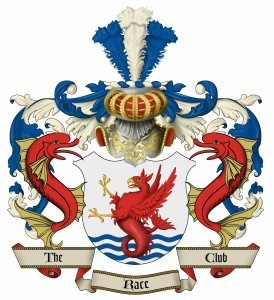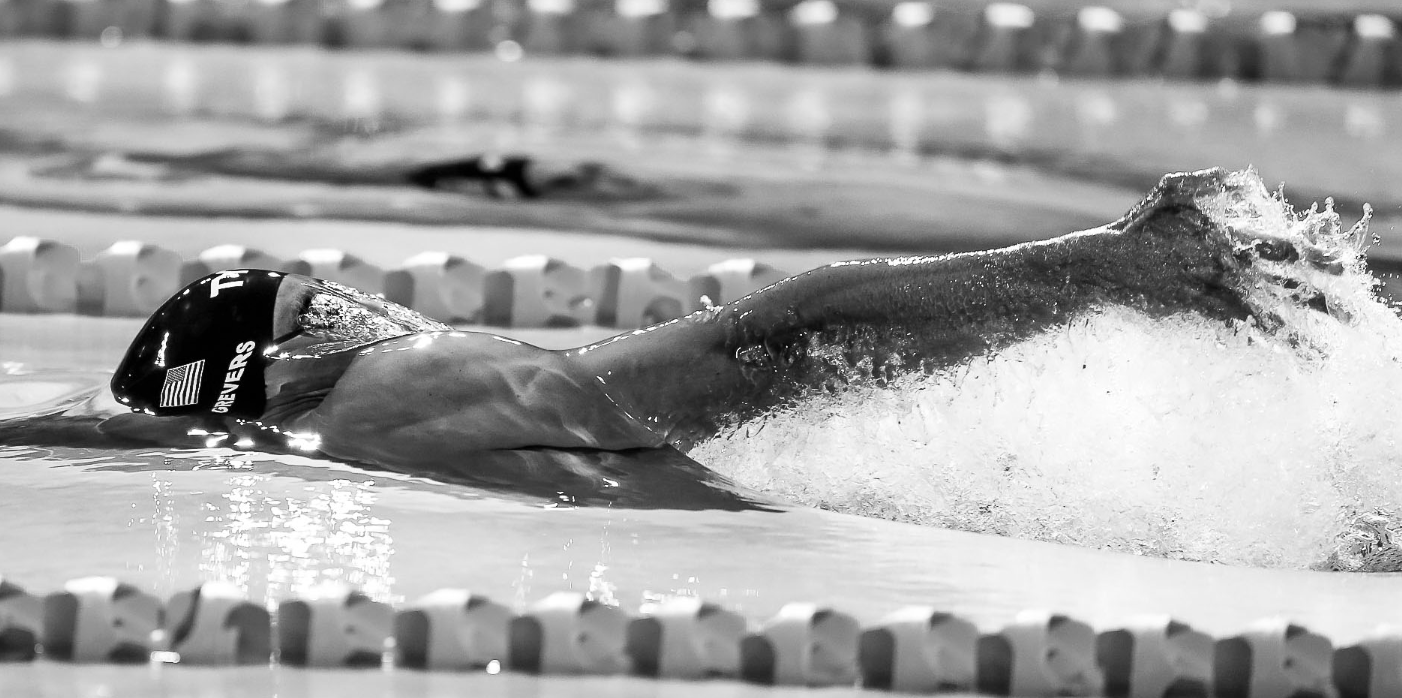Courtesy of Gary Hall Sr., 10-time World Record Holder, 3-time Olympian, 1976 Olympic Games US Flagbearer and The Race Club co-founder.
All of the elite swimmers of the world rotate their bodies along the long axis, the axis that their body is moving down the pool, while swimming freestyle and backstroke. They don’t just rotate a little bit. They rotate a lot. The question is, why?
Frontal Drag – Does It Matter
It is commonly believed by both coaches and swimmers that the reason for rotating the body is to reduce frontal drag; that the body has a lower drag coefficient on its side than it does on its stomach. Although I am all for reducing frontal drag, I do not believe that this is the reason that we rotate. I do not believe that the drag coefficient of the human body is significantly different in the water on its side than it is on its stomach. If it were, we would be kicking faster times on our sides…but we don’t.
Core Strength
The truth is that it takes a lot of core strength and work to rotate our bodies from one side to the other while moving down the pool. So if it is not to reduce drag, why then? I believe that there are two compelling reasons why we rotate our bodies on these two strokes. The first reason is a biomechanical one and the second is related to laws of motion or propulsion.
Laws of Motion or Propulsion
If I were to pin your shoulders to the wall in the gym and bring the pulley machine over, you could pull a certain amount of weight downward, using essentially the same pulling motion as you would in the water. If I unpinned your shoulders and allowed you to rotate your body inward toward the pulley machine and you duplicated that same pulling motion with the same elbow bend, I can guarantee that you will be able to pull more weight downward. The reason is that when you rotate in, your big back muscles, particularly the latissimus dorsi muscle, gets into the act. When your shoulders were pinned, that big muscle was sitting on the sidelines, unable to offer much help. By rotating our bodies in the water, we gain a biomechanical advantage of power on the pull.
Coupling – What Is It
The second reason we rotate our bodies is a little harder to understand, but it is just as important as the first. I call this second phenomenon coupling. The act of rotating our bodies from one side to the other has zero direct propulsive effect on our motion down the pool. Yet when this motion, which creates energy of its own, is coupled with the propulsive force generated by our pulling arm/hand, the two forces occurring together result in a stronger pulling force than if we were simply pulling alone, without the rotation. One can consider the relationship of these two motions synergistic.
The Coupling Effect
A good example of this coupling effect, and one that is easier to visualize, occurs with relay take-offs. With the correct start, the arms are swinging fast in reverse direction at full length at the precise moment we push off the starting block with our feet. The swinging of the arms alone has no effect of getting us off the block or down the pool, but when coupled this motion with the push off the block, it helps make the push more forceful, resulting in a better start than if we did not swing the arms.
Body Rotation – One Of The Coupling Motions
Body rotation is one of the coupling motions we use in swimming (arm recovery is another) in order to go faster. The bigger we are (more mass) and the faster we can rotate, the more energy we create to couple with the pull, and the faster we swim. When you add the biomechanical advantage that we gain from the rotation, those are two pretty important reasons to make the extra effort to rotate the body. At The Race Club we spend a lot of time teaching swimmers how to rotate the body effectively in freestyle and backstroke.

Gary Hall, Sr., Technical Director and Head Coach of The Race Club (courtesy of TRC)
Yours in swimming,
Gary Hall Sr.
https://www.facebook.com/theraceclub
http://instagram.com/theraceclub
https://twitter.com/theraceclub
https://www.linkedin.com/pub/gary-hall/9/908/671 [email protected]
<http://[email protected]
Www.theraceclub.com <http://Www.theraceclub.com
THE RACE CLUB
 Because Life is Worth Swimming, our mission is to promote swimming through sport, lifelong enjoyment, and good health benefits. Our objective is for each member of and each participant in The Race Club to improve his or her swimming performances, health, and self-esteem through our educational programs, services and creativity. We strive to help each member of The Race Club overcome challenges and reach his or her individual life goals.
Because Life is Worth Swimming, our mission is to promote swimming through sport, lifelong enjoyment, and good health benefits. Our objective is for each member of and each participant in The Race Club to improve his or her swimming performances, health, and self-esteem through our educational programs, services and creativity. We strive to help each member of The Race Club overcome challenges and reach his or her individual life goals.
The Race Club provides facilities, coaching, training, technical instruction, video, fitness and health programs for swimmers of all ages and abilities. Race Club swim camps are designed and tailored to satisfy each swimmer’s needs, whether one is trying to reach the Olympic Games or simply improve one’s fitness. Our programs are suitable for beginner swimmers, pleasure swimmers, fitness swimmers, USA swimming or YMCA swimmers, or triathletes; anyone who wants to improve swimming skills. All of our Race Club members share an enjoyment of being in the water and use swimming to stimulate a more active mind and body.

I think rotation of the swimmer also creates a powerful “torque force” which helps propel the swimmer forward. Much like screw grabs the wood and pulls itself into a denser material. The swimmer grabs the water with their hand and forearm and rotates like a screw with the core body. The hand and forearm are holding the water like the threads of the screw.
How much rotation is “a lot”?
Fantastic article, again!
I currently work with a young squad who would not understand the concepts of coupling (not sure if I do fully) so I give them the following explanation which amounts to pretty much the same point as being able to engage extra muscles. Rotation on front crawl lengthens the stroke. Allowing the shoulder to move forwards and backwards adds to the length of the pull. In backstroke the strength of the pull is greater if your hand is forward of a line drawn across your shoulder blades and extending to each side of the body. You cannot get your hand into this position (and keep it in the water) without rotation from side to side. A backstroke swimmer who is… Read more »
In explaining to my swimmers the importance of arm speed compaired to rotation we work on the timing of the catch and release. Introducing them to full body rotation we use a quick count. To self correct their arm speed each swimmer counts 1- 1000 as the hand catches the water in preparation for the second hand to reach the catch position of the stroke. We suggest that they over exaggerate the body rotation and play with the body position until they find the rotation angle of the body that gives them a constant count. As they developed their stroke and speed they have the freedom to make the changes necessary to keep the arm speed count. Also in regards… Read more »
Agreed!!!
I do not believe in rotation except just enough to set up your stroke – to keep stroke “in front of you” (freestyle) or to set up shallow arm pull (in backstroke – here I am a Russell Mark’s follower).
I think the right way is no lower body rotation AT ALL to keep kick steady and just rotate upper body enough for an efficient stroke, in both free and back.
But what do I know… it is not like I have PhD in fluid Dynamics or anything… wait, actually I do have.
So basically shoulder driven freestyle. I’m guessing that’s what you’re trying to say right
The coupling energy, and thus its effect, is related to the mass, the angular velocity squared and the radius squared. We cannot change the radius of our body rotation, but we can add more mass by rotating more of the entire body than the shoulders. The problem is that it takes more time to do so. Even in shoulder driven freestyle, which enables us to have a much higher stroke rate, the shoulders cannot rotate a lot without some rotation of the hip. There is no question that body rotation augments the effect of the underwater pull (and likely the kick, too). If it takes too long to do, however, it becomes a detriment to stroke rate and the overall… Read more »
I cannot agree with you this time psychodad, most of the time I do….rotation is big, I also think it is easier to achieve this rotation with a six beat kick in freestyle, or at least a four beat kick, but the kick is essential in my humbled opinion to achieve this desired rotation. Coach Hall is 100% correct IMHO
Anyone that has has ever kayaked gets these principles (push and pull muscles “couple” to support each other). Not to mention the coupling between kicks and pulls as well as breath trimming to create power. We will use a large paddle on the left/pull hand and a 2lb weight in the right/recovery hand thus creating more pull force by the “coupling” of the weight in the recovery hand driving the paddle on the pulling hand. This is done while making sure to drive the opposite/right leg down and the left leg up to “couple” the kick with the momentum of the weight all resulting in a stronger pull with the large paddle/pull hand. Timing is important just as referenced above… Read more »